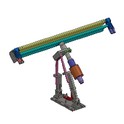Can an ultrasonic filtration system be used for carrageenan solution filtration?
Carrageenan is a widely used hydrocolloid in the food, pharmaceutical, and cosmetic industries due to its excellent gelling, thickening, and stabilizing properties. However, the filtration of carrageenan solutions can be a challenging task due to the high viscosity and tendency of carrageenan to form gels and aggregates. In this blog post, we will explore the potential of using an ultrasonic filtration system for carrageenan solution filtration, and discuss the benefits and limitations of this technology.
As a supplier of ultrasonic filtration systems, we have extensive experience in developing and implementing innovative filtration solutions for a variety of industries. Our ultrasonic filtration systems are designed to use high-frequency sound waves to enhance the filtration process by reducing the viscosity of the fluid, breaking up aggregates, and preventing the formation of filter cake. This results in higher filtration efficiency, longer filter life, and better product quality.
The principle of ultrasonic filtration is based on the phenomenon of cavitation, which occurs when high-frequency sound waves are applied to a liquid. Cavitation creates tiny bubbles in the liquid, which collapse rapidly, generating high-pressure shock waves and microjets. These shock waves and microjets can break up aggregates, disperse particles, and reduce the viscosity of the fluid, making it easier to filter.
In the case of carrageenan solutions, ultrasonic filtration can offer several advantages. First, the high-frequency sound waves can break up the carrageenan gels and aggregates, reducing the viscosity of the solution and improving the flow rate through the filter. This can result in higher filtration efficiency and shorter filtration times. Second, ultrasonic filtration can prevent the formation of filter cake, which is a common problem in carrageenan filtration. Filter cake can reduce the filtration rate and increase the pressure drop across the filter, leading to higher energy consumption and shorter filter life. By preventing the formation of filter cake, ultrasonic filtration can extend the filter life and reduce the operating costs. Third, ultrasonic filtration can improve the quality of the filtered carrageenan solution by removing impurities and particles that can affect the performance and stability of the carrageenan. This can result in a higher-quality product with better gelling, thickening, and stabilizing properties.
However, there are also some limitations to using an ultrasonic filtration system for carrageenan solution filtration. One of the main limitations is the high cost of the equipment. Ultrasonic filtration systems are more expensive than traditional filtration systems, and the cost of installation and maintenance can also be significant. Another limitation is the potential for damage to the carrageenan molecules. The high-pressure shock waves and microjets generated by cavitation can break the chemical bonds in the carrageenan molecules, leading to a reduction in the molecular weight and a change in the properties of the carrageenan. This can affect the performance and stability of the carrageenan in the final product.
To overcome these limitations, it is important to choose the right ultrasonic filtration system for the specific application. Our company offers a range of ultrasonic filtration systems, including Ultrasonic Tank Filter and Ultrasonic Pipe Filter, which are designed to meet the different needs and requirements of our customers. Our ultrasonic filtration systems are equipped with advanced control systems that allow for precise adjustment of the ultrasonic parameters, such as frequency, power, and duration, to ensure optimal performance and minimize the potential for damage to the carrageenan molecules.
In addition, it is important to conduct thorough testing and optimization of the ultrasonic filtration process before implementing it in a commercial production environment. This can help to determine the optimal ultrasonic parameters, such as frequency, power, and duration, for the specific carrageenan solution and filtration system. It can also help to identify any potential problems or limitations with the process and to develop strategies to overcome them.


In conclusion, an ultrasonic filtration system has the potential to be used for carrageenan solution filtration, offering several advantages such as higher filtration efficiency, longer filter life, and better product quality. However, there are also some limitations to using this technology, such as the high cost of the equipment and the potential for damage to the carrageenan molecules. To ensure the successful implementation of an ultrasonic filtration system for carrageenan solution filtration, it is important to choose the right equipment, conduct thorough testing and optimization of the process, and work with a experienced supplier who can provide technical support and guidance.
If you are interested in learning more about our ultrasonic filtration systems and how they can be used for carrageenan solution filtration, please contact us to discuss your specific needs and requirements. We would be happy to provide you with more information and to schedule a demonstration of our technology.
References
- "Carrageenan: A review of its properties, uses, and safety" by M. A. Rinaudo, in Carbohydrate Polymers, 2008.
- "Ultrasonic filtration: A review of its principles, applications, and limitations" by S. P. J. Higson, in Ultrasonics Sonochemistry, 2011.
- "The effect of ultrasonic treatment on the properties of carrageenan solutions" by X. Zhang, in Food Hydrocolloids, 2015.






